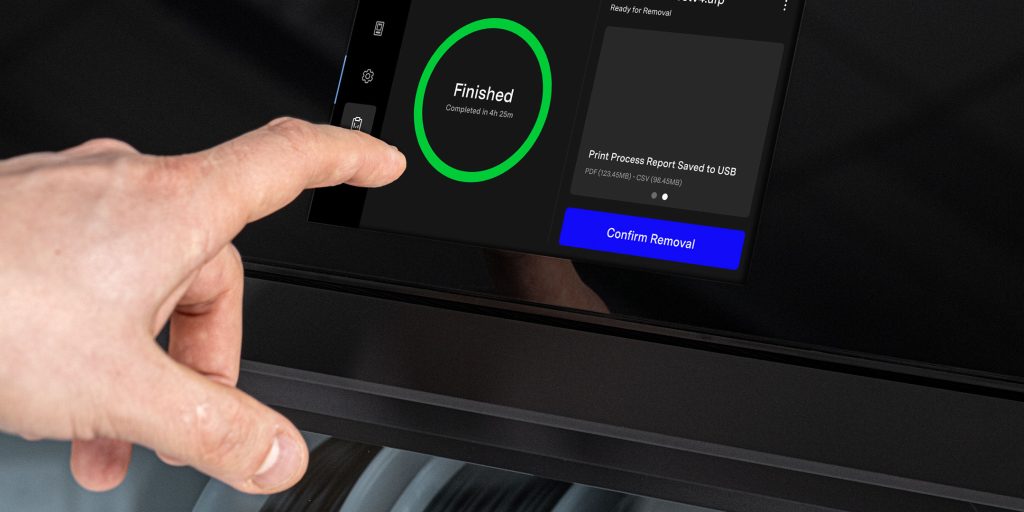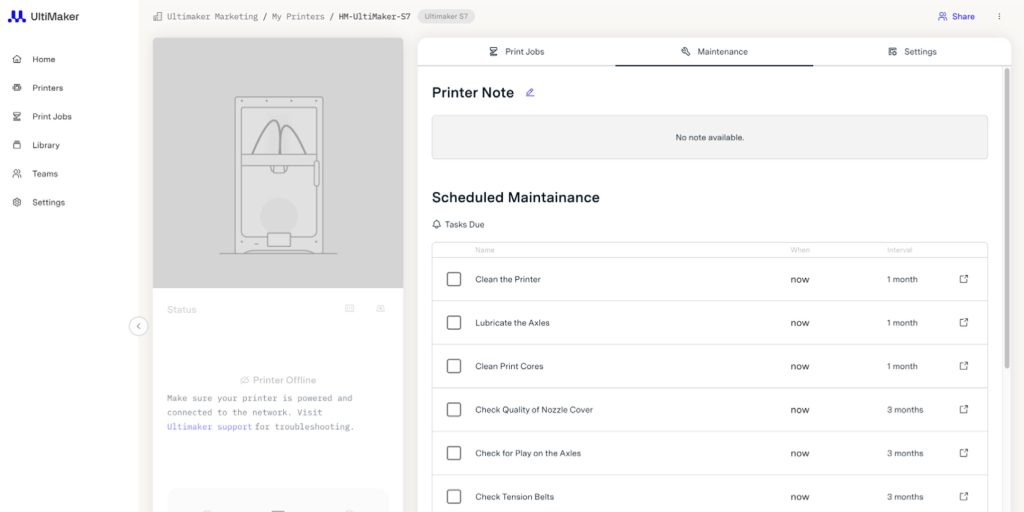This UltiMaker Factor 4 feature is game-changing
Print Process Reporting is included with every UltiMaker Factor 4, bringing users a new level of confidence through precision and validation.
That sounds good. But what is Print Process Reporting? And how does it work?
In a nutshell, this feature provides detailed, post-print reports within 15 minutes of job completion. It also monitors and evaluates critical print parameters to ensure each print adheres to predefined quality standards.
Tracking data on extrusion factors, nozzle performance, build volumes, build plate temperatures and more, Print Process Reporting compiles everything into an easy-to-read, locally accessible report. Any deviations are clearly broken down with metadata, event locations, 3D images, and graphs, enabling quick and precise validation of each part before deployment.
Below is an example first page of a print process report:
Print Process Report

This insight can also save money by identifying and addressing potential issues before they escalate. Its transparency about part integrity and manufacturing processes shines a new light on the inherent variances in additive manufacturing.
Up until now, such granular reporting is usually only possible with a lot of manual effort, or going into a completely different price bracket of 3D printers. This sets Factor 4 apart as the most cost-effective way to get this feature on the market.
Let’s dive deeper into how Print Process Reporting can transform your workflow.
How Print Process Reporting can save costs
Print Process Reporting gives you the power to catch potential issues before they become problems.
By identifying deviations that can occur during the print job, you can massively reduce the chance of the following from escalating into costly downtime:
- Internal delamination
- Inconsistent layer adhesion
- Other process-related defects
- Every print job is closely monitored, ensuring that each part adheres to rigorous quality standards before deployment.
For example, a brewery might be 3D printing replacement cogs for their packaging conveyor belt. During a routine print, Print Process Reporting detects a slight variance in filament flow rate. The report highlights this deviation with precise metadata, a 3D image, and a detailed graph, allowing the team to spot the issue immediately. By catching the problem early, the brewery engineers avoid a potential part failure that could halt their entire packaging line. This preventative insight not only saves costs but also ensures that their production schedule remains uninterrupted and efficient.
Gaining control over every print job
While traditional manufacturing (like CNC machining) is often slower and more costly, it still offers high predictability. By contrast, 3D printing offers more versatility in terms of geometric complexity, wider material choice, and less waste – all at a lower price point. And Print Process Reporting addresses any possible lack of predictability by providing monitoring and analysis, allowing users to maintain control over every print job.
This insight also applies to worker safety. With Print Process Reporting, you can have more peace of mind that critical 3D printed parts fully meet requirements and are less likely to fail. Such failures could have resulted in physical injuries for operators. But now you can be 100% confident that certified parts won’t have any potentially hazardous issues.

And for when you need to 3D print multiple parts, perhaps on different UltiMaker Factor 4 printers, perhaps in different parts of the world, Print Process Reporting plays a crucial role in ensuring batch-to-batch consistency. With such detailed process data, users can monitor and control variations in print parameters, guaranteeing uniformity in part quality and performance.
Whether producing prototypes or end-use parts, Print Process Reporting empowers engineers, manufacturers, or 3D printing service bureaus to achieve new levels of consistency and reliability in their additive manufacturing processes.
Data-driven production made easy
Print Process Reporting revolutionizes data-driven production by meticulously tracking and displaying deviations in your print jobs. This feature provides comprehensive metadata, pinpointing event locations, and presenting detailed 3D images and graphs for a thorough understanding of each print’s performance. With this level of insight, users can quickly identify any anomalies and take proactive measures to ensure the quality and integrity of their printed parts.
The versatility of Print Process Reporting extends far beyond basic error detection. This feature serves as a powerful tool for various application cases, including:
- Part validation
- Internal structural integrity checks\
- Digital certification for compliance auditing

Whether you’re manufacturing high-end tools or critical components, Print Process Reporting provides the assurance and documentation needed to meet stringent quality standards. By leveraging this feature, users can streamline their production processes, enhance part traceability, and ensure compliance with industry regulations. This effectively makes each 3D print more valuable on Factor 4.
Monitor and manage your 3D prints from anywhere
With Print Process Reporting, you gain access to high-resolution print process supervision through live video streams. This real-time monitoring capability allows you to oversee every stage of the printing process, from the initial layer to the final product. By visualizing your prints as they happen, you can detect any issues or deviations immediately, ensuring that your production runs smoothly and efficiently.
Besides live monitoring, Print Process Reporting provides downloadable reports that offer valuable insights into your production process. These reports enable you to analyze production success rates, monitor material usage, and assess machine performance. By leveraging data and analytics, you can make informed decisions to optimize your workflow, improve efficiency, and maximize the quality of your printed parts.

Print Process Reporting is seamlessly integrated into the UltiMaker Digital Factory platform, allowing you to manage your 3D prints remotely with ease. From anywhere with an internet connection, you can securely monitor active prints, schedule maintenance tasks, and ensure continuous operation of your printers. With remote management capabilities, you have the flexibility to oversee your production workflow and address any issues promptly, keeping your operation running smoothly around the clock.
How to access Print Process Reporting
Ready to experience the benefits of Print Process Reporting and upgrade your 3D printing workflow? Every UltiMaker Factor 4 comes with a premium firmware trial license, giving you access to this powerful feature. Within minutes of completing your print jobs, you can activate Print Process Reporting and start optimizing your additive manufacturing processes for increased uptime, accuracy, and repeatability.
Contact us to learn more about the Factor 4 and how it might be of benefit to you and your business.







Leave A Comment